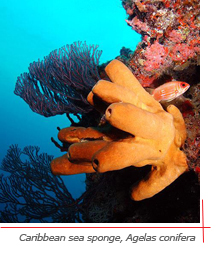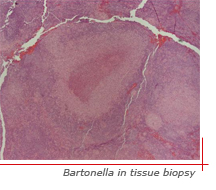

Replicating Nature Leads to Antibiotic Advances >>
NC State Startup, Galaxy Diagnostics, Fights Common Bacterial Infection >>
 Replicating Nature Leads to Antibiotic Advances ::::
Replicating Nature Leads to Antibiotic Advances ::::
NC State researchers in the Department of Molecular and Structural Biochemistry are taking a lesson from the Caribbean sea sponge, Agelas conifera, to make conventional antibiotics work gainst drug-resistant bacteria. Dr. Christian Melander, assistant professor of chemistry, and Dr. John Cavanagh, William Neal Reynolds Distinguished Professor of Molecular and Structural Biochemistry, are creating chemical compounds that can scrub away biofilms, much like the sea sponge does.
This proprietary technology has the potential to make conventional antibiotics work against stubborn, drug-resistant bacteria.
More about the research from NC State's News Services' "Taking the resistance out of drug-resistant infections," 04.10.2009: Bacteria have a number of ways of protecting themselves from antibiotics, including casing themselves in a protective barrier known as a biofilm. Biofilms comprise about 80 percent of the world’s microbial environment and are, according to statistics from the National Institutes of Health and the Centers for Disease Control, responsible for up to 80 percent of all bacterial infections.
In addition to medical concerns – certain biofilms in the lung kill cystic fibrosis patients, for example – biofilms also have enormous impacts in agriculture and industry. Biofilms destroy crops, foul ship’s hulls and coat medical devices. Biofilms also coat – don’t be alarmed – your teeth. As anyone who has had plaque scraped from their teeth knows, getting rid of biofilms once they adhere to a surface is really difficult.
To create chemical compounds that can scrub away biofilms, Melander and Cavanagh looked to a particular sea sponge, Agelas conifera, that lives in the Caribbean Sea.
“Somehow, this sponge that can’t run away and that has no immune system stays remarkably clean while everything around it is covered in biofilms, so the sponge has some molecular way of keeping them at bay,” Cavanagh said. “We’ve never seen a sea sponge up close, but we understand the chemical processes going on. So Christian devised chemical compounds to mimic the sponge compound, ageliferin, that keeps the sponge free of biofilms. Our compounds are not toxic to mammals like ageliferin is, though, and we can make the compounds in enormous quantities.”
The NC State chemical compounds don’t kill biofilms outright, but cause them to revert to their single-celled form. Common antibiotics are then able to do their job of eliminating the single-celled bacteria.
Also be sure to read the Washington Post article covering this ground-breaking research, "Scientists Learning to Target Bacteria Where They Live:" http://www.washingtonpost.com/wp-dyn/content/article/2009/03/08/AR2009030801778.html
 NC State Startup, Galaxy Diagnostics, Fights Common Bacterial Infection ::::
NC State Startup, Galaxy Diagnostics, Fights Common Bacterial Infection ::::
Based on proprietary intellectual property from the College of Veterinary Medicine, Galaxy Diagnostics focuses on bacterial DNA detection. The results are highly accurate and significantly more sensitive than other available methods for detecting infection by Bartonella.
Bartonella is a hard to detect, insect-borne pathogen linked to both acute and chronic illnesses. The bacteria are the cause of cat scratch disease, among other ailments. It can be transmitted by infected fleas, lice, sandflies and possibly ticks, but it is difficult to detect in human blood. It can be treated with antibiotics if properly diagnosed.
Human subjects with varying ranges of neurological disorders who were tested for the Bartonella bacterium and treated with antibiotics, showed signficant improvement within months. Read the article, "Man Claims He's Almost Cured Of MS:" http://www.ksat.com/health/18915077/detail.html?taf=ant
For more info, see the Galaxy website: http://www.galaxydx.com/